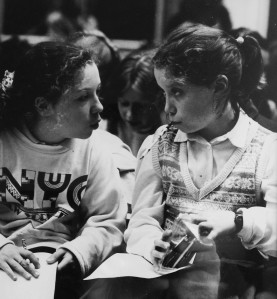There is a photograph hanging in the bathroom of my parent’s home, in which my younger sister and I are waving pencils at each other in disagreement. We are so absorbed in our argument that we failed to notice a linger noing photographer, who took his snap and approached my parents for permission to print it in The Irish Times (my parents like to think that opportunistic bit of publicity secured my future destiny.) The photograph was taken at the National Gallery of Ireland, during one of the children’s painting workshops, at which my siblings and I were regular attendees. Not because we were especially interested in art or showed any great talent, but because there were six children in our house and the workshops were free. My parents were art-lovers, sure, but more than that, they were human and the workshops allowed them to sneak off for an hour and indulge their own interests while we were entertained.

That is me scowling on the left.
And this was the general tenor of my childhood. There were Sunday recitals and sketching at the Hugh Lane. Open days at the National Concert Hall, where I also got to sing on stage with my school choir. Balloon racing and blackberry picking at IMMA, whose fields and rambling lanes have now given way to a ubiquitous housing development. There were twice-weekly visits to the library after school and Sunday excursions to Waterstones, which we treated like a library, settling down into bean bags to read books that we had no intention of buying.
If it all sounds terrifically rarefied, it was not just a matter of preference for my parents but one of necessity. Then, as now, Ireland’s national cultural institutions are free to visit, and with their public funding comes a responsibility to engage with all kinds of potential audiences: from tiny children to the disabled.
There were, however, art forms I remained entirely ignorant of: those you paid for. I went to the cinema for the first time when I was 10, (Fantasia at the Screen for a friend’s birthday), and I remember only one trip to the theatre before I turned 16 (Wind in the Willows at the Gaiety with Alan Stanford as Toad of Toad Hall). Needless to say, there was more than a little resentment from me and my siblings. More paintings! Another edition of Edward Lear! Could we not just stay at home and watch Star Wars or read Babysitter’s Club instead?
As a parent now, I see why my own parents were so keen on these family cultural outings. We were being constantly exposed to new experiences and ways of looking at the world, and we were being constantly encouraged to express our own version of it.
Inadvertently, we were absorbing lessons in individuality, imagination, cultural diversity, play. If our teachers at school gave us information about the world, these informal experiences gave us the tools to interpret the facts and make our own sense of them. A lot of the time we were also having fun.
It is for this reason that I find myself following the patterns my parents set in my own childhood, dragging my boys along to events, workshops, recitals, readings, where they can partake in the multiplicity of entertainment and edification that cultural experiences offer. And where, yes, I can indulge my own interests.
I started this blog to bring together details of the rich cultural offerings for children in Ireland, which often happen under the radar. It will be an informal record of our outings, offering a variety of musings about culture and childhood, as well as theatre and book reviews, and interviews with vested parties. It will also endeavour to provide listings for forthcoming events. Knowledge after all is power (to participate!). Your child’s future depends on it.
